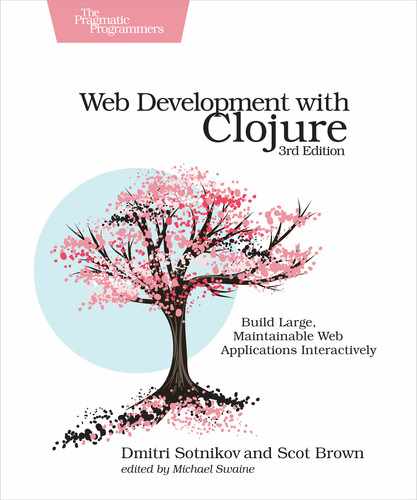Today, developers are increasingly adopting Clojure as a web-development platform. See for yourself what makes Clojure so desirable, as you create a series of web apps of growing complexity, exploring the full process of web development using a modern functional language. This fully updated third edition reveals the changes in the rapidly evolving Clojure ecosystem and provides a practical, complete walkthrough of the Clojure web-stack. Stop developing web apps with yesterday's tools. Today, developers are increasingly adopting Clojure as a web-development platform. See for yourself what makes Clojure so desirable, as you work hands-on with Clojure and build a series of web apps of increasing size and scope, culminating in a professional grade web app using all the techniques you've learned along the way. This fully updated third edition will get you up to speed on the changes in the rapidly evolving Clojure ecosystem - the many new libraries, tools, and best practices. Build a fully featured SPA app with re-frame, a popular front-end framework for ClojureScript supporting a functional style MVC approach for managing the UI state in Single-Page Application-style applications. Gain expertise in the powerful Ring stack using the Luminus framework. Learn how Clojure works with databases and speeds development of RESTful services. See why ClojureScript is rapidly becoming a popular front-end platform, and use ClojureScript with the popular re-frame library to build single-page applications. Whether you're already familiar with Clojure or completely new to the language, you'll be able to write web applications with Clojure at a professional level.
Table of Contents
- Acknowledgments
- Introduction
- 1. Getting Your Feet Wet
- 2. Luminus Web Stack
- 3. Luminus Architecture
- 4. Introducing ClojureScript
- 5. Setting Up for Success
- 6. Planning Our Application
- 7. Account Management
- 8. Social Interaction
- 9. Deployment
- 10. Exercises
- A1. Clojure Primer
- A Functional Perspective
- Data Types
- Using Functions
- Anonymous Functions
- Named Functions
- Higher-Order Functions
- Closures
- Threading Expressions
- Being Lazy
- Structuring the Code
- Destructuring Data
- Namespaces
- Dynamic Variables
- Polymorphism
- What About Global State?
- Writing Code That Writes Code for You
- The Read-Evaluate-Print Loop
- Calling Out to Java
- Calling Methods
- Reader Conditionals
- Summary
- A2. Editor Configuration
- A3. Working with EDN and Transit
- A4. Database Access
- A5. Writing RESTful Web Services with Liberator
- A6. Leiningen Templates
